A communicative approach to writing
英语教学法教程12 Teaching Writing
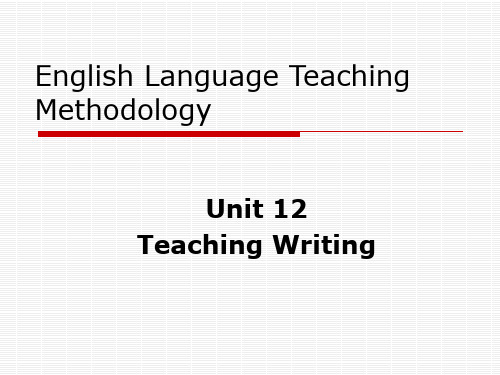
2. Why do we write?
We write for various reasons, to convey messages, to keep a record of what is in our mind, to communicate, to raise awareness of how language works, to become more familiar with the linguistic and social conventions of writing in English, etc.
details 9. Posing questions about the text 10.Finding answers to posed questions
11. Connecting text to background knowledge 12. Summarizing information 13. Making inferences 14. Connecting one part of the text to another 15. Paying attention to text structure 16. Rereading 17. Guessing the meaning of a new word from context 18. Using discourse markers to see relationships 19. Checking comprehension 20. Identifying difficulties 21. Taking steps to repair faulty comprehension 22. Critiquing the author 23. Critiquing the text 24. Judging how well objectives were met 25. Reflecting on what has been learned from the text
英语教学法教程十二单元Teaching Writing
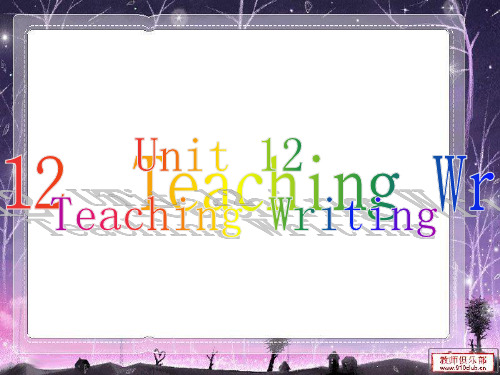
Task 2 Activity 1: it‟s obviously “writing for consolidating language”. All the Ss have to do is combine the sentence pairs into one sentence and make other minor changes. There is no communication in the activity. Activity 2:it can be considered as “writing for communication” though the situation is an imagined one. If the Ss write truly about the sightseeing possibilities in their locality the activity promotes a lot of communication. Activity 3: it can be considered as “writing for learning” and “writing for communication”. It depends on who the Ss are writing to. If the writing is to be read by classmates, there is no communication. If the writing is to be read by other people, it is communication.
Task 3 Ss should be more motivated to write the things that are more communicative and close to their daily life.
英语教学法8
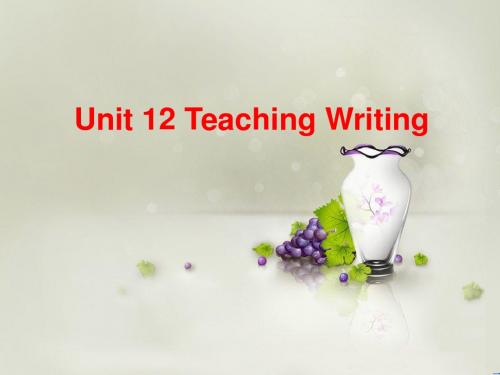
A contrast between writing in ELT classroom and writing in reality
writing in ELT classroom Purpose To consolidate language recently learned (writing as language learning) Way to Students write according to write the topic and requirements given by the teacher in limited period of time; the focus is on the final product while the process which the students go through while do the writing task is virtually ignored. writing in reality To convey message or for self creation We may have some ideas long before we put them on paper. And we often plan, draft, and rewrite. That is, we focus on the writing process.
12.1 What, why and how do we write?
What do we write?
Writing is a real-life reality. Whether it is in social, work or study situations, we write to get things done and to form and maintain social relationships. In reality there is a great variety of things we write for example, letters, journals, notes, instructions, posters, essays, reports, menus. We fill in forms, answer questionnaires and similar tasks.
高职《英语教学论》课程标准
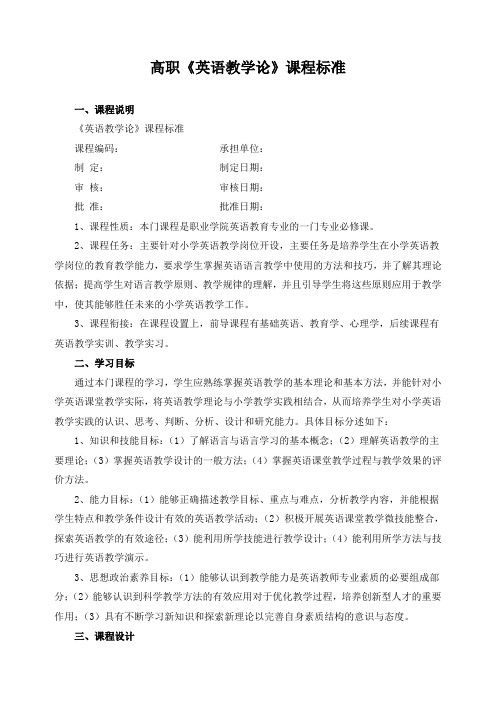
高职《英语教学论》课程标准一、课程说明《英语教学论》课程标准课程编码:承担单位:制定:制定日期:审核:审核日期:批准:批准日期:1、课程性质:本门课程是职业学院英语教育专业的一门专业必修课。
2、课程任务:主要针对小学英语教学岗位开设,主要任务是培养学生在小学英语教学岗位的教育教学能力,要求学生掌握英语语言教学中使用的方法和技巧,并了解其理论依据;提高学生对语言教学原则、教学规律的理解,并且引导学生将这些原则应用于教学中,使其能够胜任未来的小学英语教学工作。
3、课程衔接:在课程设置上,前导课程有基础英语、教育学、心理学,后续课程有英语教学实训、教学实习。
二、学习目标通过本门课程的学习,学生应熟练掌握英语教学的基本理论和基本方法,并能针对小学英语课堂教学实际,将英语教学理论与小学教学实践相结合,从而培养学生对小学英语教学实践的认识、思考、判断、分析、设计和研究能力。
具体目标分述如下:1、知识和技能目标:(1)了解语言与语言学习的基本概念;(2)理解英语教学的主要理论;(3)掌握英语教学设计的一般方法;(4)掌握英语课堂教学过程与教学效果的评价方法。
2、能力目标:(1)能够正确描述教学目标、重点与难点,分析教学内容,并能根据学生特点和教学条件设计有效的英语教学活动;(2)积极开展英语课堂教学微技能整合,探索英语教学的有效途径;(3)能利用所学技能进行教学设计;(4)能利用所学方法与技巧进行英语教学演示。
3、思想政治素养目标:(1)能够认识到教学能力是英语教师专业素质的必要组成部分;(2)能够认识到科学教学方法的有效应用对于优化教学过程,培养创新型人才的重要作用;(3)具有不断学习新知识和探索新理论以完善自身素质结构的意识与态度。
三、课程设计本课程以职业能力目标为载体,根据小学英语教学岗位工作任务要求,确定学习目标及学习任务内容;本课程采取行动导向项目教学教学模式,以学生为主体、以培养学生课堂教学能力为导向组织教学考核。
英语教学法 16.Teaching Writing
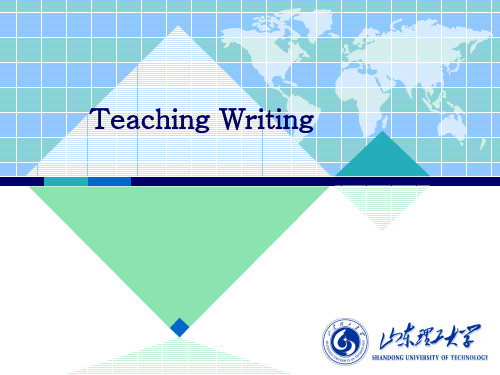
The things we write in reality: letters, journals, notes, instructions, posters, essays, reports, menus, filling forms, answering questionnaires
2. The nature of writing in reality
Task
• Read through the following writing activities and decide which activities are writing for consolidating language, which are writing for communication, and which are perhaps for both. Try to give reasons for your decision.
II. A communicative approach to writing
Communication writing means either writing for a specific recipient, or engaging in an act of creative writing. It is authentic writing tasks that have some communicative elements.
Possible solutions
• Activity 3 can be between “writing for learning” and “writing for communication”. It depends on whom the students are writing to. If the writing is to be read only by classmates, there is no communication. If the writing is to be read by other people, it is communication. • Activity 4 is typical of imaginative writing. There is a clear recipient. So the students know whom they are addressing.
teaching writing 教案
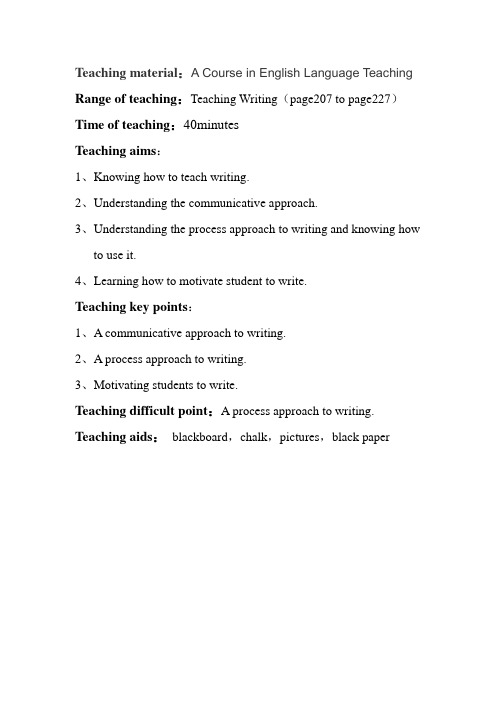
T eaching material:A Course in English Language Teaching Range of teaching:Teaching Writing(page207 to page227)Time of teaching:40minutesT eaching aims:1、Knowing how to teach writing.2、Understanding the communicative approach.3、Understanding the process approach to writing and knowing howto use it.4、Learning how to motivate student to write.T eaching key points:1、A communicative approach to writing.2、A process approach to writing.3、Motivating students to write.T eaching difficult point:A process approach to writing.T eaching aids:blackboard,chalk,pictures,black paperT eaching procedures:Communicative approach to writing;Problems in writing tasks——6minutesStarter: we have four basic skills in language learning. can you tell me what are they?Y es, they are listening/speaking/readingand writing. Until now we have learnt the first three skills.Today we are going to learning writing.Q:Do you have this memory that our teacher give us a topic and let us write in a limited time?A:…….But I think this consolidate language writing activities does not motivate students well. Because our goal of teaching writing is to motivate students, and then we should make the teaching of writing more effective and motivative. And to motivate students, it is necessary to engage them in some act of communication. That means writing should have some communicative elements.Task: please turn to page 211 and read the task 3 compare the activity 1 and activity 2. Which activity do you prefer? Ofcourse activity 2, because activity 2 is more communicativeand close to students’ daily life. And students can bemotivated by these activities.W e have learnt the communicative principles in unit 2.hopeyou can remember it, if not review it after class.Problems in writing tasks. These problems we must avoid and keep in mind.1. They are mainly accuracy-based2. They are designed to practice a certain structures.3. There is insufficient preparation before the writing stage4. There is no sense of audience5. There is no sense of authenticity6. Students are given ideas to express rather than being invitedto invent their own.7. There is no opportunity for creative writing, particular forexpressing unusual or original ideas.8. Many of them are test-oriented.W e can compare the two ways of writing activities and find out the advantages and disadvantages. In the firstcolumn it is obviously the traditional classroom writingactivity. Students should be puzzled, and they may ask whydo we must write in this style. For what purpose?In this column there is no sense of audience, the students don’t know whom they are writing to. They will lack of motivation and communication. Compared with the first column, how about the second one?It has a sense of audience and students know whom they are writing to.I think you can find the rest differences of your own, andwhen you are teaching writing, you should as the second column do.W e know that we have a process in teaching listening, and we also have a process in teaching writing.A process approach to writing(motivation); Designing writing tasks——6minutes1.Creating a motivation to write:topic---DES ①motivative ②communicativeStep 1.首先用电影《失恋33天》(LOVE IS NO BLIND)和经融海啸(Financial Tsunami)话题对比,让大家从直观上发现,设计作文题目最重要的是让学生有话可说。
英语教学理论与实践教学大纲
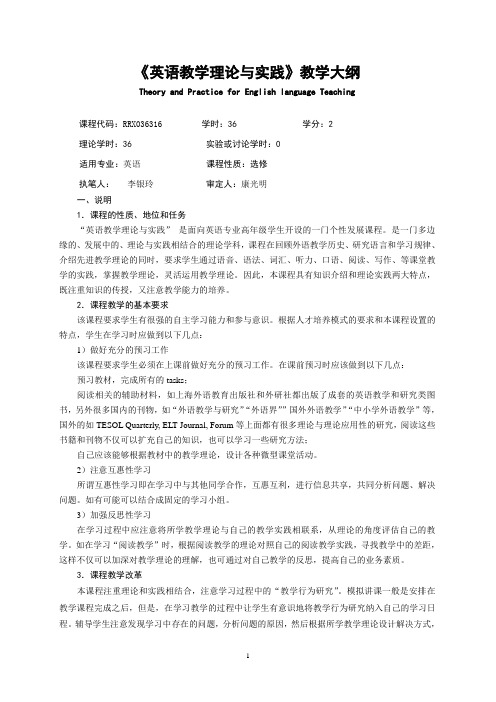
《英语教学理论与实践》教学大纲Theory and Practice for English language Teaching课程代码:RRX036316 学时:36 学分:2理论学时:36 实验或讨论学时:0适用专业:英语课程性质:选修执笔人:李银玲审定人:康光明一、说明1.课程的性质、地位和任务“英语教学理论与实践”是面向英语专业高年级学生开设的一门个性发展课程。
是一门多边缘的、发展中的、理论与实践相结合的理论学科,课程在回顾外语教学历史、研究语言和学习规律、介绍先进教学理论的同时,要求学生通过语音、语法、词汇、听力、口语、阅读、写作、等课堂教学的实践,掌握教学理论,灵活运用教学理论。
因此,本课程具有知识介绍和理论实践两大特点,既注重知识的传授,又注意教学能力的培养。
2.课程教学的基本要求该课程要求学生有很强的自主学习能力和参与意识。
根据人才培养模式的要求和本课程设置的特点,学生在学习时应做到以下几点:1)做好充分的预习工作该课程要求学生必须在上课前做好充分的预习工作。
在课前预习时应该做到以下几点:预习教材,完成所有的tasks;阅读相关的辅助材料,如上海外语教育出版社和外研社都出版了成套的英语教学和研究类图书,另外很多国内的刊物,如“外语教学与研究”“外语界””国外外语教学”“中小学外语教学”等,国外的如TESOL Quarterly, ELT Journal, Forum等上面都有很多理论与理论应用性的研究,阅读这些书籍和刊物不仅可以扩充自己的知识,也可以学习一些研究方法;自己应该能够根据教材中的教学理论,设计各种微型课堂活动。
2)注意互惠性学习所谓互惠性学习即在学习中与其他同学合作,互惠互利,进行信息共享,共同分析问题、解决问题。
如有可能可以结合成固定的学习小组。
3)加强反思性学习在学习过程中应注意将所学教学理论与自己的教学实践相联系,从理论的角度评估自己的教学。
如在学习“阅读教学”时,根据阅读教学的理论对照自己的阅读教学实践,寻找教学中的差距,这样不仅可以加深对教学理论的理解,也可通过对自己教学的反思,提高自己的业务素质。
英语全英 写作教学
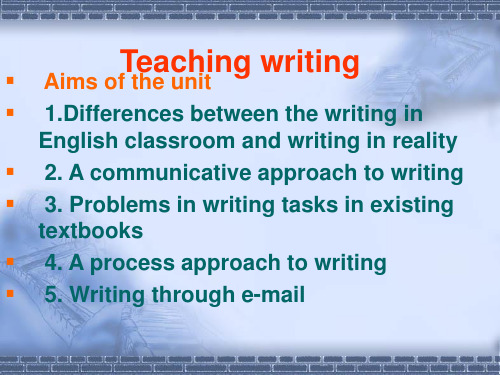
While in reality, we may have some ideas long before we put them on paper. And we often plan ,draft ,and write. Also teachers tend to overlook the quality of ideas in students‟ writing . Instead ,they only comment on the quality of the language. In the ELT classroom, writing tasks lack authenticity, they do not motivate students. It focuses on product rather than process. So they don‟t help students to develop real writing skills. However, in reality writing , we should advocate authentic writing; that is ,ask our students to write things we in reality or things they want to write about, In order to make the teaching of writing effective, we should advocate the process approach to writing , that is ,guide the students through the process of writing .
Whilst/while in reality writing, most writing as for communication, that is to convey messages or for self creation, such as poems which reflect the students‟ inner thought or feelings. Writing contents: letters, journals, notes, instructions, posters, essays, reports, menus, filling forms answering questionnaires, we write for many reasons, such as to convey messages or just to keep a record of what is in our mind and then do a lot of editing and proof-reading.
《中学英语教学法》模拟试题
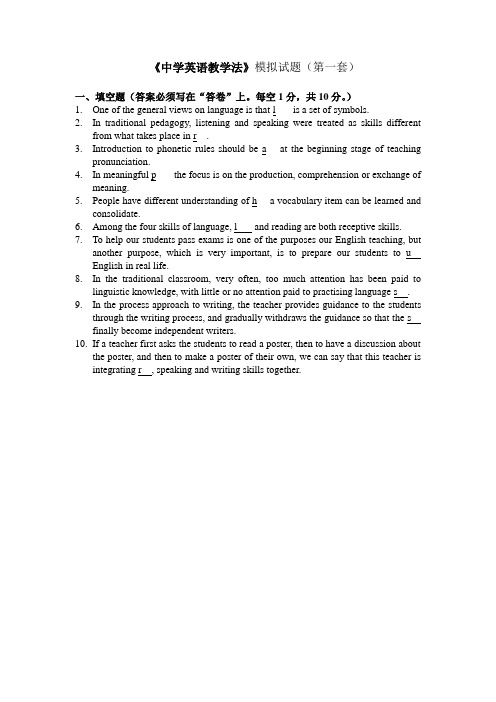
《中学英语教学法》模拟试题(第一套)一、填空题(答案必须写在“答卷”上。
每空1分,共10分。
)1.One of the general views on language is that l___ is a set of symbols.2.In traditional pedagogy, listening and speaking were treated as skills differentfrom what takes place in r__.3.Introduction to phonetic rules should be a__ at the beginning stage of teachingpronunciation.4.In meaningful p___ the focus is on the production, comprehension or exchange ofmeaning.5.People have different understanding of h__ a vocabulary item can be learned andconsolidate.6.Among the four skills of language, l___ and reading are both receptive skills.7.To help our students pass exams is one of the purposes our English teaching, butanother purpose, which is very important, is to prepare our students to u__ English in real life.8.In the traditional classroom, very often, too much attention has been paid tolinguistic knowledge, with little or no attention paid to practising language s__. 9.In the process approach to writing, the teacher provides guidance to the studentsthrough the writing process, and gradually withdraws the guidance so that the s__ finally become independent writers.10.If a teacher first asks the students to read a poster, then to have a discussion aboutthe poster, and then to make a poster of their own, we can say that this teacher is integrating r__, speaking and writing skills together.二、配对题(答案必须写在“答卷”上。
[职业资格类试卷]中学教师资格认定考试(高级英语学科知识与教学能力)模拟试卷37.doc
![[职业资格类试卷]中学教师资格认定考试(高级英语学科知识与教学能力)模拟试卷37.doc](https://img.taocdn.com/s3/m/737c4d80fd0a79563c1e72fe.png)
[职业资格类试卷]中学教师资格认定考试(高级英语学科知识与教学能力)模拟试卷37[职业资格类试卷]中学教师资格认定考试(高级英语学科知识与教学能力)模拟试卷37一、单项选择题1 Which of the following words has the proper word stress?(A)e'conomic(B)'machinery(C)chimpan'zee(D)'precarious2 Which of the following is the proper pronunciation of "meet you" as a result of assimilation?(A)/mi:t ju:/(B)/mi:t ju/(C)/mi:tju:/(D)/mi:tju:/3 We take our skin for granted until it is burned______repair.(A)beyond(B)for(C)without(D)under4 When it was time for our ticket to be______, I couldn't find mine.(A)controlled(B)bought(C)checked(D)overlooked5 Table tennis has wide appeal, and I hope thousands of sports lovers will______ these outdoor tables.(A)take advantage of(B)take notice of(C)take charge of(D)take note of6 We can' t help you______you tell us what' s wrong.(A)since(B)unless(C)if(D)when7 A similar wrong idea is that fish and ice cream when______ at the same time form a poisonous combination.(A)eating(B)being eaten(C)eaten(D)to be eaten8 _____ difficulties we may come across, we'll help one another to overcome them. (A)Wherever(B)Whatever(C)However(D)Whenever9 Which of the following is not a design feature of human language?(A)Arbitrariness.(B)Displacement.(C)Duality.(D)Diachronicity.10 "Can I borrow your bike?"______"You have a bike."(A)is synonymous with(B)is inconsistent with(C)entails(D)presupposes11 Which of the following statements about the Situational Approach is NOT true? (A)Adopt an inductive approach to grammar teaching.(B)Encourage explanations of the meaning of new items in foreign language. (C)Focus on language accuracy.(D)Practice structures and patterns through repetition and substitution activities.12 When designing speaking tasks, we must follow the principles except______. (A)maximum foreign talk(B)even participation(C)high motivation(D)high language level13 ______ aims to help students to pay attention to teaching content efficiently at the beginning of the class.(A)Lead-in(B)Presentation(C)Preparation(D)Practice14 What purpose do post-listening activities NOT serve?(A)Helping students relate the text with their personal experience.(B)Offering students the opportunities of extending other language skills.(C)Practicing students' ability of matching the pre-listing predictions with contents of the text.(D)Enabling students to have a discussion about the topic.15 Which of the following activities can be adopted at the pre-reading stage?(A)Re-arranging the materials.(B)Brainstorming the topic.(C)Writing a summary of the text.(D)Locating the specific information.16 Which of the following elements does not belong to a communicative writing task?(A)a sense of authenticity(B)accuracy-based(C)process-oriented(D)students-focused17 What role does the teacher play at the feedback stage?(A)Assessor.(B)Promoter.(C)Controller.(D)Resource-provider.18 When a teacher helps students deal with the information gap of real discourse, he/she probably aims at developing students' ______.(A)linguistic competence(B)strategic competence(C)discourse competence(D)fluency19 Which of the following types of questions can least elicit students' ideas?(A)Display questions.(B)Divergent questions.(C)Open questions.(D)Evaluation questions.20 Which of the following about teaching assessment is inappropriate?(A)Diagnostic assessment is a kind of test carried out after a teaching activity.(B)Formative assessment should be student-oriented.(C)Summative assessment is often carried out at the end of a term.(D)Portfolios, daily reports, and delivering speeches are all formative assessment.二、简答题21 词汇的用法包括哪些内容?简述词汇用法的呈现与讲解方法,从中选取两种方法进行举例说明。
中学英语学科知识和教学能力模拟试卷和答案解析(10)

2021年中学英语学科知识与教学能力模拟试卷与答案解析10一、单选题(共30题)1.Which role does the teacher play in the following activities When the students are doing a group work task, the teacher joins one or two groups for a short period of time.A:source of helpB:controllerC:participantD:assessor【答案】:C【解析】:本题考查教师的角色。
根据题干中的关键词“join in”,教师加入小组活动中,真正成为小组活动的一员与小组成员互动,可知正确答案为“participant”,综上,C选项正确。
A选项,资源的帮助者,不合题意,故排除。
B选项,控制者,不合题意,故排除。
D选项,评价者,不合题意,故排除。
故正确选项为C。
2.Match the adjectives on the left with the nouns on the right. A:GroupingB:CollocationC:ImitationD:Imagery【答案】:B【解析】:本题考查新课标相关的学习策略B选项,搭配,根据题意可知,本题考查的是学习策略在教学中的运用,“将左边的形容词与右边的名词搭配对”训练的是词的搭配,综上,B选项正确。
A选项,分组,故排除。
C选项,模仿,故排除。
D选项,想象,故排除。
故正确答案为 B 项。
3.When a teacher intends to present or explain a new language point, which of the following group methods is mostly recommended?A:pair workB:whole-class workC:individualD:group work【答案】:B【解析】:本题考查课堂分组。
教学法复习
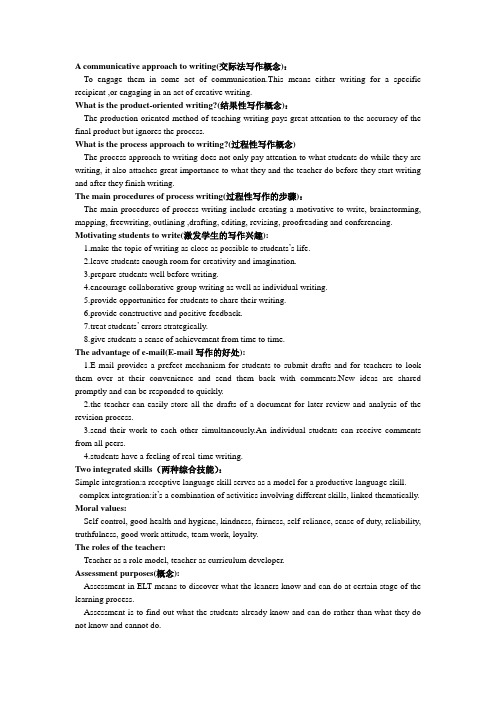
A communicative approach to writing(交际法写作概念):To engage them in some act of communication.This means either writing for a specific recipient ,or engaging in an act of creative writing.What is the product-oriented writing?(结果性写作概念):The production-oriented method of teaching writing pays great attention to the accuracy of the final product but ignores the process.What is the process approach to writing?(过程性写作概念)The process approach to writing does not only pay attention to what students do while they are writing, it also attaches great importance to what they and the teacher do before they start writing and after they finish writing.The main procedures of process writing(过程性写作的步骤):The main procedures of process writing include creating a motivative to write, brainstorming, mapping, freewriting, outlining ,drafting, editing, revising, proofreading and conferencing. Motivating students to write(激发学生的写作兴趣):1.make the topic of writing as close as possible to students’s life.2.leave students enough room for creativity and imagination.3.prepare students well before writing.4.encourage collaborative group writing as well as individual writing.5.provide opportunities for students to share their writing.6.provide constructive and positive feedback.7.treat students’ errors strategically.8.give students a sense of achievement from time to time.The advantage of e-mail(E-mail写作的好处):1.E-mail provides a prefect mechanism for students to submit drafts and for teachers to look them over at their convenience and send them back with comments.New ideas are shared promptly and can be responded to quickly.2.the teacher can easily store all the drafts of a document for later review and analysis of the revision process.3.send their work to each other simultaneously.An individual students can receive comments from all peers.4.students have a feeling of real-time writing.Two integrated skills(两种综合技能):Simple integration:a receptive language skill serves as a model for a productive language skill. complex integration:it’s a combination of activities involving different skills, linked thematically. Moral values:Self-control, good health and hygiene, kindness, fairness, self-reliance, sense of duty, reliability, truthfulness, good work attitude, team work, loyalty.The roles of the teacher:Teacher as a role model, teacher as curriculum developer.Assessment purposes(概念):Assessment in ELT means to discover what the leaners know and can do at certain stage of the learning process.Assessment is to find out what the students already know and can do rather than what they do not know and cannot do.Methods for assessment(评价方法):Summative assessment is mainly based on testing.It is done mostly at the end of a learning periods or the end of a school year.Formative assessment is based on information collected in the classroom during the teaching process for the purposes of improving teaching and learning.The way to gather information(收集信息的方法):Testing, teacher’s observations, continuous assessment, self-assessment and peer assessment, project work, portfolios.Criteria for assessment(评价的标准):Criterion-referenced assessment:Criterion-referenced language assessment is based on a fixed standard or a set criterion.Norm-referenced assessment:Norm-referenced assessment is designed to measure how the performance of a particular student or group of students compares with the performance of another students or group of students whose scores are given as the norm.Individual-referenced assessment:Individual-referenced assessment is based on how well the learner is performing relative to his or her own previous performance, or relative to an estimate of his or her individual ability.Different types of learners (学习者的类型):Visual learners : learn more effectively though the eyes (seeing).Auditory learners: learn more effectively though the ear (hearing).Tactile learners: learn more effectively though touch (hands-on).They learn things by doing. Kinesthetic learners: learn more effectively though body experience.Group learners: learn more effectively though working with others.Individual learners: learn more effectively though working alone.Authority learners: prefer to listen to the teacher more than work with others or work alone. Reflective leaners:learn more effectively when given time to consider options.Multiple-intelligence(多元智能理论):Howard Gardener1.V erbal/Linguistic Intelligence(语言言语智能):The ability to use words effectively, both orally and in writing.2.Musical Intelligence(音乐旋律智能):Sensitivity to rhythm, pitch, and melody.3.Logical/Mathematical Intelligence(逻辑数学智能):The ability to use numbers effectively and reason well.4.Spatial/ Visual Intelligence(空间视觉智能):Sensitivity to form, space, colour, line and shape.5.Bodily/Kinesthetic Intelligence(身体运动智能):The ability to use the body to express ideas and feelings, to solve problems.6.Interpersonal Intelligence(人际关系智能):The ability to understand another person’s mood, feelings, motivations,and intentions.7.Intrapersonal Intelligence(自我认知智能):The ability to understand your strengths, weaknesses, moods, desires, and intentions.8.Naturalist Intelligence(自然观察智能):This is the ability to appreciate the naturalist world and enjoy outdoor activities.The way to learner training/How to help students learn(怎样培养学生的学习能力):1.involve students in an overview of the textbook at the beginning.2.involve students in finding out about themselves.3.introduce students to a number of different learning strategies.4.help leaners set up their own learning goals and make their own plans.5.share lesson aims with students in class and review them by the end of the lesson.e learner diaries as a way to help student reflect on their learning.7.guide students to make plans for learning.e portfolios to promote more autonomous learning.9.help students learn to use resources.How you can create your own resources for teaching and learning (怎样开发隐性资源):e yourself as resourcesing students as resources3.making use of students’ drawings4.making use of surroundings5.shadow theatre6.exploring emotions7.getting students to make their own dictionaries8.letting students to make up their own quizzes9.making batter use of video resourcesing songs for learning11.internet as an important resourceTwo types of evaluation(评价教材的两种方法):On-the-page evaluation:is carried out independent of its users or before it gets into the classroom.In-the-use evaluation: is done based on the users’ opinions i.e. teachers’ as well as learners’, about how useful and effective it is for promoting learning.Two steps of on-the-page evaluation (on-the-page evaluation 的两个步骤):External evaluation:①focus on the external features of a textbook .It is also called macro evaluation.②focus on its internal features ,which maybe termed as micro evaluation.Internal evaluation: intends to investigate the following aspects of a textbook.Features of good textbooks(怎样的教材是好的教材):1.good textbooks should attract the students’ curiosity, interest and attention.2.textbooks should help students feel at ease.3.textbooks should help students develop confidence.4.textbooks should meet students’ needs.5.textbooks should expose students to language in authentic use.6.textbooks should provide students with opportunities to use the target language to achieve communicative purposes.7.textbooks should take into account that the positive effects of language teaching are usually delayed.8.textbooks should take into account that students differ in learning styles.9.textbooks should take into account that students differ in effective factors.10.textbooks should maximise learning potential by encouraging intellectual, aesthetic and emotional involvement which stimulates both right and left brain activities.Suggestions for adapting materials(调整教材的方法):1.Adding2.Deleting or omitting3.Modifying4.Simplification5.ReorderingThree steps of textbook adaption(调整步骤):The first step is macro adaptation ,which is ideally done before the language programme begins. The second step of adaptation is adapting a unit.The third step is adaptation of specific activities in a unit.。
Lecture 9 Teaching Productive Skills---speaking and writing

Lecture 9 Teaching Productive Skills ---speaking and writingRelated material:unit 10 Teaching Speakingunit 12 Teaching Writingspeaking writingOutline-to understand the nature of writing in reality-to learn the communicative approach to writing-to understand the process approach to writing-to evaluate writing1. The nature of writing in realityDifferences in realityWhat do we write? Why do we write? How do we write?letters, e-mails, dairies, notes, essays, poems, reports,... convey messagesplan, write, correct, rewrite2.A communicative approach to writingTo motivate students, it is necessary to engage them in some act of communication, we should advocate authentic writing.Case : compare 2 examples: e.g. 1WritingWrite about the sports which you e phrases like these:I don ’t like …I enjoy …My favourite sport is …I quite like …I prefer …to …I like …because …no sense of audience,no sense of authenticitye.g. 2A pen pal has written to you and hasdescribed the sports that he/she likes most. He/She asked your favourite sports. If you have something in common, you may want to talk about it or suggest that you play it together sometime in the future. Write back to your pen pal.Students can be motivated by authentic writing tasks that have some communicative elements.Case : compare two topics☐write on "the cars in next century"☐write on "description of a presentvehicle"Ss always like creation.Case: writing for communication?writing for language consolidation?Case: which is more communicative?Students are given ideas to expressrather than being invitedto invent their own.Summary of writing topic design☐In short students can be motivated by authentic writing tasks that have some communicative elements.☐However some writing activities can be between “writing for language practice”and “writing for communication”.2.The Models of Teaching Writing⏹Product-oriented Approach⏹结果写作法⏹Process-oriented Approach⏹过程写作法2.1 Product-oriented ApproachTeacher gives the titleStudents writeTeacher correct them2.2 Process-oriented Approach Pre-writingDraftingRevisingSecond draftTeacher’sfeedback写作主要教学活动举例写前活动写时活动写后活动•激活灵感;•激发兴趣;•明确目的和读者对象;•讨论主题;•搜集素材;•语言准备;•阅读范文;•写初稿;•规划文章结构;•填空;•看图作文;•图文转换;•仿写;•连句成文。
英语教学法复习要点

英语教学法复习要点1.Structural view on language:The structural view of language sees language as a linguistic system made up of various subsystems: the sound system(phonology);the discrete units of meaning produced by sound combinations(morphology), and the system of combining units of meaning for communication(syntax). Each language has a finite number of such structural items. To learn a language means to learn these structural items so as to be able to understand and produce language. When this structural view of language was combined with the stimulus-response principles of behavioristic psychology, the audiolingual approach to language learning emerged.2.Interactional view on language:The interactional view considers language to be a communicative tool, whose main use is to build up and maintain social relations between people. Therefore, learners not only need to know the grammar and vocabulary of the language but as importantly they need to know the rules for using them in a whole range of communicative contexts.municative competence:The goal of CLT is to develop students' communicative competence, which includes both the knowledge about the language and the knowledge about how to use the language appropriately in communicative situations.There are five main components of communicative competence: linguistic competence, pragmatic competence, discourse competence, strategic competence, fluency4.Task in English language teaching:Task-based Language Teaching is a further development of Communicative Language Teaching. It shares the same beliefs,,as language should be learned as close as possible to how it is used in real life. However, it has stressed the importance to combine form-focused teaching with communicative-focused teaching.5.Overall language ability:•Learning:cognitive; self management; communication; resourcing•Language learning: listening; speaking; reading; writing•Language: phonetics; grammar; vocabulary; functions; topics•Cultural: knowledge; understanding; awareness•Affect: international; perspectives; patriotism; confidence; motivationponents of a lesson plan:background information; teaching aims; language contents and skills; stages and procedures; teaching aids; end of lesson summary; optional activities and assignments; after-lesson reflection.7.The role of the teacher:controller, assessor, organizer, prompter, participant, resource-provider, facilitators, guides, researchers8.Errors and mistakes:a mistake has nothing to do with the language competence, buta result from a temporary breakdown. When a mistake is challenged or given enough attention, it can be self-corrected. An error has direct relation with the learners' language competence. Errors do not result from carelessness nor hesitation, but lack of knowledge in the target language. Language errors cannot be self-corrected no matter how much attention is given.9.The goal of teaching pronunciation:Consistency: the pronunciation should be smooth and natural; Intelligibility: the pronunciation should be understandable to the listeners; Communicative efficiency: the pronunciation should help convey the meaning that is intended by the speaker.10.Principles for teaching speaking:balancing accuracy-based with fluency-based practices; contextualising practice; personalising practice; building up confidence; maximising meaningful interactions; helping students develop speaking strategies; making the best use of classroom learning environment to provide sufficient language input and practice for the students.11.Mechanical practice:involves activities that are aimed at form accuracy. By doing mechanical practice, the students pay repeated attention to a key element in a structure. Substitution and transformation drills are most frequently used in mechanical practice.12.Meaningful practice:in meaningful practice, the focus is on the production, comprehension or exchange of meaning though the students 'keep an eye on' the way newly learned structures are used in to process. Meaningful practice usually comes after mechanical practice.13.The deductive method:relies on reasoning, analyzing and comparing. Frist, the teacher writes an example on the board or draws attention to an example in the textbook. Then the teacher explains the underlying rules regarding the forms and positions of certain structural terms. Sometimes, comparisons are made between the native language and the target language or between the newly presented structure and previously learned structure. Finally, the students practice applying the rule to produce sentences with given prompts.14.Guided discovery method:The guided discovery method is similar to the inductive method in that the students are induced to discover rules by themselves but different in that the process of the discovery is carefully guided and assisted by the teacher and the rules are then elicited and taught explicitly. There are two key theoretical issues related to this method: the role of explicit knowledge in language learning and the value of discovery as a general method of learning.15.Knowing a word:Knowing a word means knowing its pronunciation and stress; itsspelling and grammatical properties; its meaning; how and when to use it to express the intended meaning.16.V ocabulary consolidation activities:labelling; spot the difference; describe and draw; play a game; use word series; word bingo; word association; find synonyms and antonyms; categories; using word net-work17.Connotative meaning of a word:A connotative meaning of a word refers to 'the attitudes or emotions of a language user in choosing a word and the influence of these on the listener or reader's interpretation of the word. These would include words that may express a positive or negative attitude or subtle feelings towards something.18.Denotative meaning of a word:Denotative meaning of a word of a lexical item refers to those words that we use to label things as regards real objects, such as a name or a sigh, etc. in the physical world. This is usually the primary meaning of a word and may seem relatively easy to learn.19.V ocabulary learning strategies:review regularly, guess meaning from context, organize vocabulary effectively, use a dictionary, manage strategy use20. Top-down model of listening:In the top-down model, listening for gist and making use of the contextual clues and background knowledge to construct meaning are emphasized.21.Bottom-up model of listening:In the bottom-up model, listening comprehension is believed to start with sound and meaning recognitions. In other word, 'we use information in the speech itself to try to comprehend the meaning'. Listeners construct meaning of what they hear based on the sound they hear. This process of listening expects the listener to have a very effective short-term memory as they have to make sense of every sound in order to figure out the meaning of words, phrases and structures. If there are unfamiliar sounds, listeners will find it very hard to keep up with the speaker.22.Sight vocabulary:Words that one is able to recognise immediately are often referred to as sight vocabulary. In other words, your sight vocabulary will be those words that you can recognise with both sounds and meanings without special effort from your brain.23.Interactive model for teaching reading:24.The transition device:The way to transfer information from one form to another is called a transition device. Some transition devices that are often used in teachingreading are: pictures, drawings, maps, tables, tree diagrams, cyclic diagrams, pie charts, bar charts, flowcharts, chronological sequence, subtitles and notes. Most of the transition devices listed above make use of visual aids so that information in text form is visualized.The purpose of transition device:•Focus attention on the main meaning of the text;•Be able to simplify sophisticated input so that it becomes the basis for output; •Allow students to perform tasks while they are reading;•Highlight the main structural organization of a text/part of a text, and show how the structure relates to meaning;•Involve all the students in clearly defined reading tasks;•Precede one step at a time;•When a TD is completed, use it as a basis for further oral and/or written language practice.25.A communicative approach to writing:It acknowledges that mechanical writing activities do not by themselves motivate students. To motivate students, it is necessary to engage them in some act of communication. This means either writing for a specific recipient, or engaging in an act of creative writing where their work is intended to be read by other people, in other words, an intended audience. In short, students can be motivated by authentic writing tasks that have some communicative elements.26.The process approach to writing:creating a motivation to write, brainstorming, mapping, freewriting, outlining, drafting, editing, revising, proofreading, conferencing。
英语教学法第二版 复习提纲
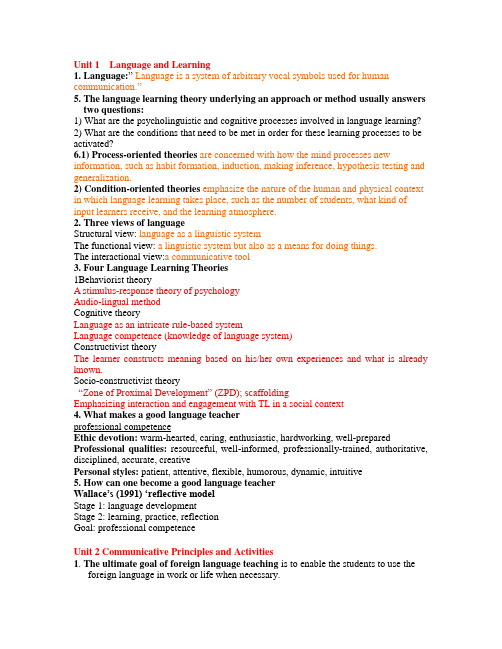
Unit 1 Language and Learning1. Language:” Language is a system of arbitrary vocal symbols used for human communication.”5. The language learning theory underlying an approach or method usually answers two questions:1) What are the psycholinguistic and cognitive processes involved in language learning?2) What are the conditions that need to be met in order for these learning processes to be activated?6.1) Process-oriented theories are concerned with how the mind processes new information, such as habit formation, induction, making inference, hypothesis testing and generalization.2) Condition-oriented theories emphasize the nature of the human and physical context in which language learning takes place, such as the number of students, what kind of input learners receive, and the learning atmosphere.2. Three views of languageStructural view: language as a linguistic systemThe functional view: a linguistic system but also as a means for doing things.The interactional view:a communicative tool3. Four Language Learning Theories1Behaviorist theoryA stimulus-response theory of psychologyAudio-lingual methodCognitive theoryLanguage as an intricate rule-based systemLanguage competence (knowledge of language system)Constructivist theoryThe learner constructs meaning based on his/her own experiences and what is already known.Socio-constructivist theory“Zone of Proximal Development” (ZPD); scaffoldingEmphasizing interaction and engagement with TL in a social context4. What makes a good language teacherprofessional competenceEthic devotion: warm-hearted, caring, enthusiastic, hardworking, well-prepared Professional qualities: resourceful, well-informed, professionally-trained, authoritative, disciplined, accurate, creativePersonal styles: patient, attentive, flexible, humorous, dynamic, intuitive5. How can one become a good language teacherW allace’s (1991) ‘reflective modelStage 1: language developmentStage 2: learning, practice, reflectionGoal: professional competenceUnit 2 Communicative Principles and Activities1. The ultimate goal of foreign language teaching is to enable the students to use theforeign language in work or life when necessary.1. The goal of CLT is to develop students‟ communicative competence.2.What is communicative compentence?3.Try to list some of its components and their implication to teaching.Communicative compentence refers to both the knowledge about the language and the knowledge about how to use the language appropriately in communicative situations. According to Hedge, it includes five components.Linguistic competence --- knowledge of the language itself, its form and meaning Pragmatic competence --- the appropriate use of language in social contextDiscourse competence--- one‟s ability to create cohere nt written text or conversation and the ability to understand them (ability to express or to understand a topic logically and coherently by effectively employing or comprehending the cohesive markers used in the discourse /ability to initiate, develop, enter, interrupt, check, or confirm in a conversation)Strategic competence--- strategies one employs when there is communication breakdown due to lack of resourcesFluency---- one‟s ability to …link units of speech together with facility and without strain or inappropriate slowness or undue hesitation4.Implications for teaching and learning:Linguistic competenceTeachers need to help learners----achieve accuracy in the grammatical forms of the language;----pronounce the forms accurately;----use stress, rhythm, and intonation to express meaning;----build a range of vocabulary;----learn the script and spelling rules;----achieve accuracy in syntax and word formation.Pragmatic competenceTeachers need to help learners---learn the relationship between grammatical forms and functions;---use stress and intonation to express attitude and emotion;---learn the scale of formality;---understand and use emotive tone;---use the grammatical rules of language;---select language forms appropriate to topic, listener, or setting, etc.Discourse competenceTeachers need to help learners----take longer turns, use discourse markers and open and close conversations;----appreciate and be able to produce contextualised written texts in a variety of genres; ----be able to use cohesive devices in reading and writing texts;----be able to cope with authentic texts.Strategic competenceTeachers need to enable learners----to take risks in using the language;----to use a range of communicative strategies;----to learn the language needed to engage in some of these strategies, e.g. …What do you call a thing that/person who…‟Teachers need to help learners-----deal with the information gap of real discourse;-----process language and respond appropriately with a degree of ease;-----be able to respond with reasonable speed in …real time”.5. Richards and Rodgers(1986:72)three principles of Communicative language teaching1) Communication principle: Activities that involve real communication promote learning.2) Task principle: Activities in which language is used for carrying out meaningful taskpromote learning.3) Meaningfulness principle: Language that is meaningful to the learner supports he learning process.16. Littlewood’s (1981)classification of communicative activities:1). Functional communicative activities:2). Social interaction activities:(1). Functional communicative activities:~ Identifying pictures~ Discovering identical pairs~ Discovering sequences or locations~ Discovering missing information~ Discovering missing features~ Discovering "secrets"~Communicating patterns and pictures~ Communicative models~ Discovering differences~ Following directions~ Reconstructing story-sequences~ Pooling information to solve a problem(2). Social interaction activities:~ Role-playing through cued dialogues~Role-playing through cues and information~Role-playing through situation and goals--Role-playing through debate or discussion~ Large-scale simulation activities~ Improvisation17.Ellis (1990) has listed six criteria for evaluating communicative classroom activities:1). Communicative purpose:2). Communicative desire:3). Content, not form:4). Variety of language:5). No teacher intervention:A task is believed to have four components:a purpose,a context,a product.任务情景化:有需要解决的问题;需要行动或语言+非语言类任务目标化学会行动;完成语言+非语言类任务复杂性;复杂成果;难以预料短期内不明显练习情景化:无需要解决的问题;纯语言练习(理想的是,一次解决一个语言难点)目标化学会行动;完成纯语言练习复杂性;单一成果;事先预设,明显但有限度(对/错)6.Differences between PPP and TBLT1.The way students use and experience language in TBLT is radically different from PPP. Free of language controlA genuine need to use language to communicateA free exchange of ideasAppropriateness & accuracy of language form in general, not production of a single form A genuine need for accuracy and fluency2TBL can provide a context for grammar teaching and form-focused activities.A task-established contextEncouraged to think, analyze, not simply to repeat, manipulate and apply A more varied exposure to natural languageLanguage forms not pre-selected for focusLearner-free selection of languageFluency accuracy (+fluency)Integrated skills practisedProblems with CLT1.Is it practical in the Chinese context?2.How to design the syllabus for classroom teaching?3.Is it suitable for all age level of learners or all competence level of learners? Constraints of TBLT1.It may not be effective for presenting new language items2.Time: teachers have to prepare task-based activities very carefully.3.Culture of learning4.Level of difficultyUnit 3National English Curriculum3.1 A brief history of foreign language teaching in China1A phase of restoration (1978-1985)2A phase of rapid development (1986-1992)3A phase of reform (1993-2000)4A phase of innovation from 20002,Designing principles for the National English Curriculum1) Aim for educating all students, and emphasize quality-oriented education.2) Promote learner-centeredness, and respect individual differences.3. Develop competence-based objectives, and allow flexibility and adaptability4) Pay close attention to the learning process, and advocate experiential learning and participation5. Attach particular importance to formative assessment, and give special attention to the development of competence.6. Optimize learning resources, and maximize opportunities for learning and using the language.3.3Goals and objectives of English language teachingThe new curriculum is designed to promote students‟ overall language ability3.4 Design of the National English CurriculumNine competence-based levelsLevel 2,For 6th gradersLevel 5,For 9th gradersLevel 7,For senior high school leaversUnit 4 Lesson Planning18. Lesson planningLesson planning means making decisions in advance about what techniques, activities and materials will be used in the class.19. Why is lesson planning necessary?1)Makes teachers aware of the aims and language contents of the lesson, so as to plan the activities and choose the techniques accordingly;2)Helps teachers distinguish the various stages of a lesson and see the relationship between them so that the activities of different difficulty levels can be arranged properly and the lesson can move smoothly from one stage to another;3)Gives teachers the opportunity to anticipate potential problems so that they can be prepared;4)Gives teachers, esp. novice ones, confidence in class;5)Raises teachers‟ awareness of the teaching aids needed;6)Planning is a good practice and a sign of professionalism21. There are four major principles behind good lesson planning:AimVariety means planning a number of different types of activities and where possible introducing students to a wide selection of materials so that learning is always interesting, motivating and never monotonous for the students.Flexibility means planning to use a number of different methods and techniques rather than being a slave to one methodology. This will make teaching and learning more effective and more efficient.Learnability means the contents and tasks planned for the lesson should be within the learning capability of the students. Of course, things should not be too easy either. Doing things that are beyond or below the students' coping ability will diminish their motivation (Schumann, 1999).Linkage means the stages and the steps within each stage are planned in such a way that they are somehow linked with one another. Language learning needs recycling and reinforcement.24. Lesson planning should be done at two levels:Macro planning is planning over time, for instance, the planning for a month, a term, or the whole course.micro planning: is planning for a specific lesson, which usually lasts 40 or 50 minutes. 25.Macro planning involves:1) Knowing about the course:2) Knowing about the institution:3) Knowing about the learners:4) Knowing about the curriculum/syllabus5)Knowing about the textbook6)Knowing about the objectives26. The advantage of a concrete teaching plan:Teachers can follow it in the class and check what they have done;The plan will be the basis of a record of what has been covered in class;It will make it easier to make achievement tests later;It will be good records for the entire course.4.4 Components of a Lesson Plan1.Background information2.Teaching aimsnguage contents and skills4.Stages and procedures5.Teaching aids6.end of lesson summary7.optional activities and Assignments8.after-lesson reflection28. The aims of a lesson include:language components to present,communicative skills to practice,activities to conductmaterials to be usedteaching aids to be used.Unit 5 Classroom Management1.What is classroom management?Classroom Management refers to the way teachers organize what goes on in the classroom.1. Teachers’ roles:Before the class---PlannerDuring the class—1 Controlle2 Assessor3 Organizer4 Prompter5 Participant6 Resource-providerAfter the class---Evaluatornew roles:facilitatorsguidesresearcher s2.Rules to follow for making instructions effectiveTo use simple instructions and make them suit the comprehension level of thestudents.To use the mother-tongue only when it is necessary. (to explain grammar rules or rules for a game or task which may be too complicated to explain in the targetlanguage)3. What are the most common types of Ss grouping?Whole class workPair work,Group work,Individual study:4.How to maintain discipline?P.79When students are engaged in learning, they will be disciplined.Q: How to engage students in learning?1)Ss are clear about learning purpose;2)Ss are able to do the work but find it challenging;3)Ss are emotionally, physically and intellectually involved by the tasks;4)The presentation, variety and structure of the work and activities generate curiosity and interest;5)Ss have opportunities to ask questions and try out ideas;6)Ss can see what they have achieved and how they had made progress;7)Ss get a feeling of satisfaction and enjoyment from the work.4. Harmer’s suggestions on measures for undisciplined acts and badly behaving Ss:1). Act immediately2). Stop the class3).Rearrange the seats4).Change the activity5).Talk to Ss after class6).creat a code of behavior5. In order not to hurt the Ss,Ur’s advice on problems in class:1).Deal with it quietly2).Don‟t take things personally 对事不对人3).Do not use threats6. What are the functions or purposes of questions?To focus students‟ attentionsTo invite thinking or imaginationsTo check understandingTo stimulate recall of informationTo challenge studentsTo assess learning7How to ask effective question1)Questions should be closely linked to the learning objectives in the lesson;2)Questions should be staged so that the level of challenge increases as the lesson proceeds;3)There should be a balance between closed and open, lower-order and higher-order questions;4)Wait time is important to allow students to think through their answers;5)Ss should be provided opportunities to ask their own questions and seek their own answers;6)A secure and relaxed atmosphere of trust is needed and ss‟ opinions and ideas are valued..6. correct dealing with errors and mistakeswe need to be clear whether the task or activity is focusing on accuracy or fluency.How to correct error:Direct teacher correctionIndirect teacher correctionSelf correctionPeer correctionWhole class correctionUnit 6Teaching Pronunciation1.The role of pronunciationOn the value of teaching pronunciation, there are different opinions:1.Students do not need to learn pronunciation because pronunciation will take care of itself as the students develop overall language ability.2.Failure in pronunciation is a great hindrance to language learn.2. The goals of teaching pronunciation:目的Consistency 连贯性: To be smooth naturalIntelligibility可理解性:To be understandable to the listenersCommunicative efficiency: To help convey the speakers‟ meaning3. Three aspects of pronunciation to teach? Stress, intonation, rhythm4. One common problem in learning English of Ss: (Neglect stress and intonation)5. Ways of practicing soundsPerception practice :Using minimal pairs,Which order,Same or different,Odd one out, CompletionProduction practice: Listen and repeat,Fill in the blanks,Make up sentences,Use meaningful context,Use pictures,Use tongue twisters6. Practicing stress:1).Two kinds of stress: word-level stress ; phrase-level stress2).Three ways to show stress pattern of words:Use gestures, use the voice, use theblackboard7. Practicing intonation:1). There are many subtle ways: surprise, complaint, …sarcasm讥讽,friendliness, threats etc.2). Two ways to make intonation:Use hand or arm movement to indicate change of intonaton: rising/falling arrows; draw linesUnit 7. Teaching Grammar1. What are grammar presentation methods? 演示法Deductive method演义法; Inductive method归纳法the guided discovery method (引导发现法2. Deductive method1). Definition: It relies on reasoning, analyzing and comparing.2). Steps: giving rules/definition------giving examples3). Advantages:To be successful with selected and motivated students;To save time;To help to increase students‟ confidence in some exam.4). Disadvantages:To teach grammar in the isolated way;To pay little attention to meaning;To be often mechanical practice.3. Inductive method1).Definition: the teacher induces the learners to realise grammar rules without any form of explicit explanation2). Steps: give examples-----induce rules4). Advantages: Inductive method is more effective in that students discover thegrammar rules themselves while engaged in language use,4. Ur’s definition of grammar practice:"Practice may be defined as any kind of engaging with结合/保证the language on the part of the learner, usually under the teacher supervision, whose primaryobjective(aim/task) is to consolidate learning "(Ur, 1988:11).5. Ur’s six factors contribute to successful grammar practice:1) Pre-learning.2) Volume and repetition(容量/重复).3) Success-orientation成功性联系.4) Heterogeneity多样性.5) Teacher assistance.6) Interest.6. Two categories of grammar practice:Mechanical practiceMeaningful practice.1).Mechanical practice involves activities that are aimed at form accuracy.Two drills in mechanical practice:(1) Substitution drills (2) Transformation drills2). Meaningful practice.In meaningful practice the focus is on the production, comprehension orexchange meaning though the students "keep an eye on" the way newly learnedstructures are used in the process. Meaningful practice usually comes aftermechanical practice.7. Using prompts for practice:1). Using picture prompts. Ss produce sentences based on the pictures provided2). Using mime or gestures as prompts.3).Using information sheet as prompts. E.g.:4). Using key phrases or key words as prompts.5). Using chained phrases for story telling.6). Using created situations.Unit 8 Teaching Vocabulary1. What does knowing a word involve?Knowing a word means knowing its pronunciation and stress;Knowing a word means knowing its spelling and grammatical properties;Knowing a word means knowing its meaning;Knowing a word means knowing how and when to use it to express the intended meaning.Vocabulary learning “involves at least two aspects of meaningThe first aspect involves the understanding of its denotative and connotative meaning.The second aspect involves understanding the sense relations among words.”Collocation , Synonyms,antonyms,hyponyms, Receptive and productive vocabulary2. List some ways of presenting new words1) Try to provide a visual or physical demonstration whenever possible,2) Provide a verbal context to demonstrate meaning.3) Use synonyms or antonyms to explain the meanings.4) Use lexical sets or hyponyms to show relations of words and their meanings.5) Translate and exemplify,6) Use word formation rules and common affixes7) Teach vocabulary in chunks.8) Think about the context in real life where the word might be used.9) Think about providing different context for introducing new words.10) Prepare possible misunderstanding or confusion that student may have.3. Some vocabulary consolidation activities that can be done in class. (12)1) Labeling2) Spotting the differences:3) Describing and drawing:4) Playing a game:5) Using word thermometers:6) Using word series7) Word bingo:9) word association10) Synonyms and antonyms:11) categories12) Using word net-work13)using the internet resources for more ideas4. Developing vocabulary building strategies.1). Review regularly:2). Guess meaning from context:3). Organize vocabulary effectively:4). Use a dictionary:5)keep a vocabulary notebook6).Discovery strategiesUnit 9Teaching Listening1.The reason why such difficulties arise can be quire complicated. however, one major reason for students‟ poor listening is often neglected in language due to1) Lack of teaching materials (audio and video tapes);2) Lack of equipment (tape players, VCRs, VCDs, computers);3) Lack of real-life situations where language learners need to understand spoken English;2 What do we listen to in everyday life? (Ur, 1996)Loudspeaker announcements1.Radio news2.Lesson, lecture3.Conversation, gossip4.Instructions5.Watching television6.Watching movies7.Telephone conversations8.Interview9.Shopping10.Story-telling11.Meetings12.Negotiations13.Theater show…3. One reason for students' unsatisfactory listening abilities:There is not enough variety in the materials that they listen to in class. In most cases, the listening materials are daily conversations or stories. But in reality we listen to far more things, regardless of which language is used.4. The characteristics of listening in real life (adapted from Ur, 1996:106-7):1) Spontaneity2) Context3) Visual clues4) Listener‟s response5) Speaker‟s adjustment5 Two major purposes in listening.*The first is for social reasons;*The second is for exchanging information.6 Principles of teaching listening:1). Focus on process:2). Combine listening with other skills:3). Focus on comprehending meaning:4). Grade difficulty level appropriately:7.dels for teaching listeningbottom-up model up- bottom modelthe teaching of listening generally follows three stages:pre-listening stagewhile-listening stage,post-listening stage.Unit 10Teaching Speaking1. What is speaking?Speaking is a skill that the students will be judged upon most in real-life situations.. 1.what are the differences between spoken and written language?SpokenspontaneousSentences are often incomplete, ungrammatical, and full of hesitations, false starts, and redundancies.If it is not recorded, spoken language can‟t be listened to again. It is expected to be understood immediately.WrittenWell-plannedSentences are often carefully constructed and well organized.Written language is comparatively speaking permanent. It can be read as often as necessary.3.There are four common features of spoken language:Using less complex syntax;Taking short cuts, e.g. incomplete sentences;Using fixed conventional phrases/chunks;Using devices such as fillers, hesitation devices to give time to think before speaking.4.Principles for teaching speaking1) balancing between accuracy-based practice and fluency-based practices :2) Contextualizing practice3) Personalizing practice4) Building up confidence5) Maximizing meaningful interactions6) Helping students develop speaking strategies7)making the best use of classroom learning environment to provide sufficient language input and practice for the students.5,factors should be considered in designing speaking tasksWhen we design speaking tasks, one important consideration is the language proficiency level of the students.6.how can we design speaking activities:1). Maximum foreign talk:2). Even participation3). High motivation4). Right language level4.Types of speaking activitiesLittlewood‟s (1981) framework for defining speaking activities:Pre-communicative activitiesStructural activitiesQuasi-communicative activitiesCommunicative activitiesFunctional communication activitiesSocial interaction activitiesSome speaking activities1)Controlled activities2)semi- Controlled activities3)communication activities1). Information-gap activities:2). Dialogues and role-plays3). Activities using pictures4). Problem-solving activities8,How to organise speaking activities.Using group work in speaking tasks☐Design small group work for three reasons:(1) it increases the time for each student to practise speaking in one lesson;(2) often ss are afraid of making mistakes or losing face or feel shy speaking in front of a whole class;(3) speaking in small groups is more natural in real life.☐Small group work helps ss learn to work cooperatively and helps them develop interpersonal skills—”foste ring development of tolerance, mutual respect andharmony” (Cooke & Nicholson, 1992:34)2). The advantages of using group in speaking tasksSmall group work helps students learn to work cooperatively and it helps them develop interpersonal skills. They learn how to work with a wider variety of people Development of tolerance, mutual respect and harmonyUnit 11 Teaching Reading1. Two types of reading practice in classrooms:Reading aloud and Silent reading2. Effective readers do the following:1) have a clear purpose in reading;2) read silently;3) read phrase by phrase, rather than word by word;4) concentrate on the important bits, skim the rest, and skip the insignificant parts;5) use different speeds and strategies for different reading tasks;6) perceive the information in the target language rather than mentally translate;7) guess the meaning of new words from the context, or ignore them;8) have and use background information to help understand the text.3. What is readingreading is the construction of meaning from a printed or Written message..4. Skills readers need:1.Specifying a purpose for reading2.Planning what to do/what steps to take3.Previewing the text4.Predicting the contents of the text5.Checking predictions6.Skimming the text for the main idea7.Scanning the text for specific information8.Distinguishing main ideas from supporting details9.Posing questions about the text10.Finding answers to posed questions5.The role of vocabulary in reading:Day & Bamford (1998): efficient reading begins with a lightening-like automatic recognition of words, which frees one‟s mind to use other resources to construct meaning. Helping ss to develop the ability of automatic word recognition is the basis for developing their reading skills.The way to develop si ght vocabulary is to read extensively (…Familiarity breeds automaticity‟).6. Some principles for teaching reading(6):1)The selected texts and attached tasks should be accessible to the students.2)Tasks should be clearly given in advance.3) Tasks should be designed to encourage selective and intelligent reading for the main meaning4) Tasks should help develop students' reading skills5) Teachers should help the students not merely to cope with one particular text in front of them but with their reading strategies and reading ability in general.6)Teachers should help the students to read on their own.7.three models of teaching reading1). Bottom-up modelletters---words---phrases---clauses---sentences---paragraphs---whole discours2). Top-down modelbackground knowledge--- guess meaning from the printed page3)Interactive model8. Three stages of reading:Pre-reading activities;While-reading activities;Post-reading ActivitiesPre-reading activities;Predictinga). Predicting based on the titleb). Predicting based on vocabularyc). Predicting based on the T/F questions2). Setting the scene* Besides discussing culture bound aspects of the text, we can also set the scene by relating what students already know to what they want to know.3). SkimmingSkimming means reading quickly to get the gist, i.e. the main idea of the text. Some suggestions may help teachers to set up skimming activities:。
英语教学理论及方法教案

1.What are the different ways for student grouping?
3. How can we maintain discipline in the classroom?
课时分配
课堂讲授1/3,实践2/3
教学
方法
讲授,实践
教学手段
网络教学();多媒体(√)
教学
用具
粉笔录音机CD与教学相关的实物
教 学 内 容 提 要
备注
In this unit, we are going to look at one of the most important components of language teachers’work, leson planning. Focus on the following
章序
名称
Unit 3 Lesson Planning
周次
第6周至第8周
授课时间
2007年4月9日至2007年4月27日
教学
目的
要求
教学目的:学习教案的写作方法
教学要求:掌握教案的写作方法
教学
重点
写好教案的原则、教案的组成
教学
难点
宏观教案和微观教案
教学场所
环境
教室
授课
方式
课堂讲授(√);实验();实践(√);双语()
课时分配
课堂讲授1/3,实践2/3
教学
方法
讲授,实践
教学手段
网络教学();多媒体(√)
教学
用具
粉笔录音机CD与教学相关的实物
英语教学法教程
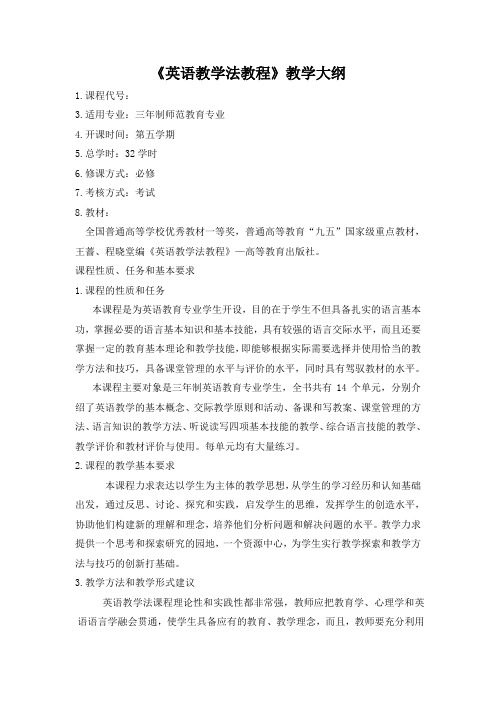
《英语教学法教程》教学大纲1.课程代号:3.适用专业:三年制师范教育专业4.开课时间:第五学期5.总学时:32学时6.修课方式:必修7.考核方式:考试8.教材:全国普通高等学校优秀教材一等奖,普通高等教育“九五”国家级重点教材,王蔷、程晓堂编《英语教学法教程》—高等教育出版社。
课程性质、任务和基本要求1.课程的性质和任务本课程是为英语教育专业学生开设,目的在于学生不但具备扎实的语言基本功,掌握必要的语言基本知识和基本技能,具有较强的语言交际水平,而且还要掌握一定的教育基本理论和教学技能,即能够根据实际需要选择并使用恰当的教学方法和技巧,具备课堂管理的水平与评价的水平,同时具有驾驭教材的水平。
本课程主要对象是三年制英语教育专业学生,全书共有14个单元,分别介绍了英语教学的基本概念、交际教学原则和活动、备课和写教案、课堂管理的方法、语言知识的教学方法、听说读写四项基本技能的教学、综合语言技能的教学、教学评价和教材评价与使用。
每单元均有大量练习。
2.课程的教学基本要求本课程力求表达以学生为主体的教学思想,从学生的学习经历和认知基础出发,通过反思、讨论、探究和实践,启发学生的思维,发挥学生的创造水平,协助他们构建新的理解和理念,培养他们分析问题和解决问题的水平。
教学力求提供一个思考和探索研究的园地,一个资源中心,为学生实行教学探索和教学方法与技巧的创新打基础。
3.教学方法和教学形式建议英语教学法课程理论性和实践性都非常强,教师应把教育学、心理学和英语语言学融会贯通,使学生具备应有的教育、教学理念,而且,教师要充分利用多媒体教学设备,采用微格教学等多种教学方法,使学生尽可能多地获得理性理解和感性理解。
而课堂时间非常有限,这就要求学生课上、课下相结合。
4.课程教学要求的层次A.要求学生掌握语言教学基本知识B.选择并使用恰当的教学方法和技巧C.学会课堂管理与教学评价学时分配学时分配:课程教学总学时数为32学时,其中理论 16学时,实践16学时。
A-communicative-approach-to-writing
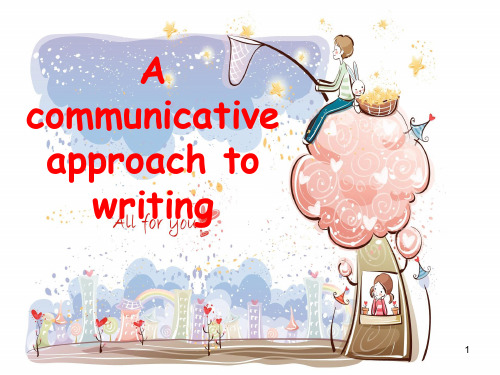
7
Writing for learning
Writing for communication
8
Activity1 Join the pairs of sentences,using when\where Example: Kentucky is the state.Lincoln was born. Kentucky is the state where Lincoln was born. 1.This book is about the time.Lincoln was President then. 2.This is the house.Lincoln was born there.
Students can be motivated by authentic writing tasks that have some communicative
elements
6
A Day on the farm
Do students have been to a farm?
What is the audience of the wrtiing?
4
Current methodology acknowledges
Written exercises as a means to consolidate
language already studied
Mechanical writing activities
do not by themselves motivate students
Between “writing for learning”and “writing for communication
11
感谢您的阅读收藏,谢谢!
writing
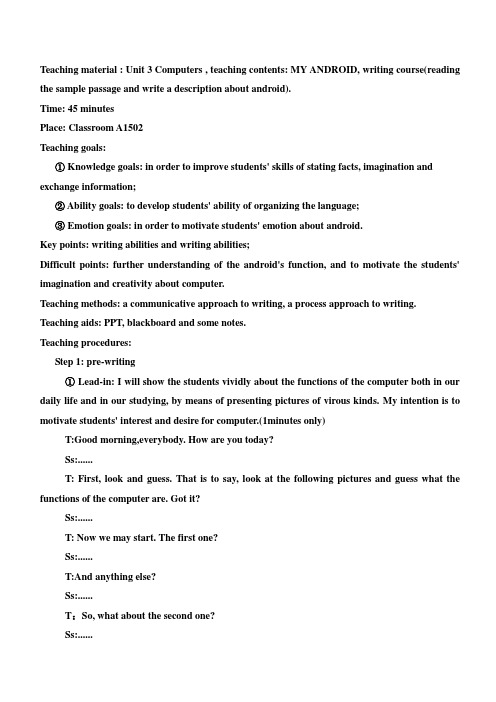
Teaching material : Unit 3 Computers , teaching contents: MY ANDROID, writing course(reading the sample passage and write a description about android).Time: 45 minutesPlace: Classroom A1502Teaching goals:① Knowledge goals: in order to improve students' skills of stating facts, imagination and exchange information;② Ability goals: to develop students' ability of organizing the language;③ Emotion goals: in order to motivate students' emotion about android.Key points: writing abilities and writing abilities;Difficult points: further understanding of the android's function, and to motivate the students' imagination and creativity about computer.Teaching methods: a communicative approach to writing, a process approach to writing. Teaching aids: PPT, blackboard and some notes.Teaching procedures:Step 1: pre-writing① Lead-in: I will show the students vividly about the functions of the computer both in our daily life and in our studying, by means of presenting pictures of virous kinds. My intention is to motivate students' interest and desire for computer.(1minutes only)T:Good morning,everybody. How are you today?Ss:......T: First, look and guess. That is to say, look at the following pictures and guess what the functions of the computer are. Got it?Ss:......T: Now we may start. The first one?Ss:......T:And anything else?Ss:......T:So, what about the second one?Ss:......T:Any other ideas?Ss:......T: So? This one?Ss:......T:Well done! Then next.Ss:......T:Very near, think it over.Ss:......T:Go on?Ss:......T:You have done a good job!How about the last one?Ss:......T: That's wonderful, everybody!②Give each student a small note so as to write down some words to describe the android on their own, both adjectives and word phrases are permitted, at least 5. This is limited within 2 minutes.T: Now I will give each of you a small note to write down some words to describe the android on your own, both adjectives and word phrases are OK. Attention, 2minutes only. Now you may go! (2 minutes later) Now,finished? Who would like to share with us? Have a try! Volunteers? Take it easy!Ss:......T: Great !And anybody else?Ss:......T: Now exchange your note with your partner and realize the same and different ones. I will give you more time.Step 2: while-writing①Let the students plan the structure of the article, and then look at the pictures provided, so as to motivate their imagination.T: Look at the pictures on the right provided, how do you think of them?Ss:......②By reading the sample passage carefully, I will have an explanation about the difficult words(mop:v.擦,揩;n.拖把;deal with: do with, handle 处理,对待;watch over:照看,照顾;niece: 侄女,外甥女). And then write an description of "my android" on their own. 5minutes is provided.T: Please read the sample passage carefully, and pay attention to the difficult words (mop:v.擦,揩;n.拖把;deal with: do with, handle 处理,对待;watch over:照看,照顾;niece: 侄女,外甥女). And then write an description of "my android" on your own (50-60 words).5 minutes is provided. Now you can start. (5 minutes later) Now finished?Ss:......Step 3: post-writing①Have a self-revisal.②Revise by helping with each other.③Have a hot discussion among the group members and point out the merits and shortness existed.④Check out the grammar, logic, vocabulary, spelling, and the punctuation marks.⑤Cope the article once again and hand it on.T: Firstly, have a self-revisal; secondly,revise by helping with each other; thirdly, have a hot discussion among the group members and point out the merits and shortness existed, including the grammar, logic, vocabulary, spelling and so on; finally, copy the article once again and hand it on.T: Our homework today is to write list of computer's functions, at least 10.And next class please remember to hand it on. Got it?Ss:......T: Thanks for your cooperation. Each of you has done a good job! Please don't forget the homework. Wish you have a happy weekend.Blackboard design: Unit 3 ComputersHomework: write a list of computer's functions, at least 10.After-class reflection:①Let the students make comments on the learning process, learning activities and learning interests.②Point out the problems and give advice about the further learning.③In terms of what they have learned and their way of learning, designing a paper for them to write down their individual suggestions.。
- 1、下载文档前请自行甄别文档内容的完整性,平台不提供额外的编辑、内容补充、找答案等附加服务。
- 2、"仅部分预览"的文档,不可在线预览部分如存在完整性等问题,可反馈申请退款(可完整预览的文档不适用该条件!)。
- 3、如文档侵犯您的权益,请联系客服反馈,我们会尽快为您处理(人工客服工作时间:9:00-18:30)。
Students can be motivated by authentic writing tasks that have some communicative elements
Do students have been to a farm? A Day on the farm What is the audience of the wrtiing?
Writing for consolidating language
Letter writing A friend is coming to visit your hometown.Unfortunately you will be away.write a short letter to your friend and make some suggestion about sightseeing and other activities in your area.
Writing for learning
Writing for communication
Activity1 Join the pairs of sentences,using when\where Example: Kentucky is the state.Lincoln was born. Kentucky is the state where Lincoln was born. 1.This book is about the time.Lincoln was President then. 2.This is the house.Lincoln was born there.
Current methodology acknowledges
Written exercises as a means to consolidate language already studied
Mechanical writing activities do not by themselves motivate students
A communicative approach to writing
What is the communicative approach
?
• The communicative approach (CA) was developed by Robert Langs MD, In the early 1970's. It is a new theory of emotional life and psychoanalysis that is centered on human adaptations to emotionallycharged events--with full appreciation that such adaptations take place both within awareness (consciously) and outside of awareness (unconsciously)..
How to motivate students? ?
Writing a letter to a friend or parent Writing for a specific recipient
Engage in an act of creative writing where their work Is intended to be read by other people
• The approach gives full credence to the unconscious side of emotional life and has rendered it highly sensible and incontrovertible by discovering a new, validated, and deeply meaningful way of decoding unconscious messages
A tour report? A letter?a journal? With different audiences and different purposes, the writing piece could vary greatly Note: Not everything can be puerly communicative
Wrபைடு நூலகம்ting for communication
Write an advertisement for each of the following products. You can write your advertisement based on your imagination.
Between “writing for learning”and “writing for communication
